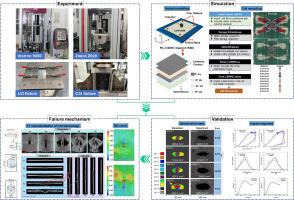新型CFRP冲击后压缩破坏模拟框架
IF 9.4
1区 工程技术
Q1 ENGINEERING, MECHANICAL
International Journal of Mechanical Sciences
Pub Date : 2025-09-24
DOI:10.1016/j.ijmecsci.2025.110888
引用次数: 0
摘要
研究了碳纤维增强环氧复合材料层合板在低速(LVI)和中速(MVI)冲击下的压缩后强度(CAI)。在不同能量水平下进行了冲击试验,以表征动态响应和损伤模式。通过整合Puck破坏准则、连续损伤力学(CDM)和基于表面的内聚行为,建立了应变率相关的有限元(FE)模型来模拟层内和层间损伤。层内模型通过Abaqus/Explicit中的VUMAT子程序实现。开发了基于python的界面,将基体开裂和永久压痕等关键损伤变量提取并传递到具有相应边界和加载条件的CAI模型中。这种新颖的建模方法避免了经验损伤等效,能够更准确地模拟渐进式层间损伤和分层损伤。预测的力-位移曲线、能量吸收和分层面积与实验结果吻合较好。最后,系统分析了不同冲击能量对冲击响应、破坏机制和CAI强度的影响,为评估复合材料结构的损伤容限提供了一个有效且有效的数值框架。本文章由计算机程序翻译,如有差异,请以英文原文为准。

Novel simulation framework for compression-after-impact failure in CFRP
This study investigates the compression-after-impact (CAI) strength of carbon fibre-reinforced epoxy composite laminates subjected to low-velocity (LVI) and medium-velocity (MVI) impacts. Impact experiments at varying energy levels were conducted to characterise the dynamic response and damage modes. A strain rate-dependent finite element (FE) model was developed by integrating the Puck failure criterion, continuum damage mechanics (CDM), and surface-based cohesive behaviour to simulate intra- and inter-laminar damage. The intralaminar model was implemented via a VUMAT subroutine in Abaqus/Explicit. A Python-based interface was developed to extract and transfer key damage variables, such as matrix cracking and permanent indentation, into the CAI model with corresponding boundary and loading conditions. This novel modelling approach avoids empirical damage equivalence and enables more accurate simulation of progressive intralaminar and delamination damage. Predicted force-displacement curves, energy absorption, and delamination areas showed strong agreement with experimental results. Finally, the effects of varying impact energies on impact response, failure mechanisms, and CAI strength were systematically analysed, providing an efficient and validated numerical framework for assessing the damage tolerance of composite structures.
求助全文
通过发布文献求助,成功后即可免费获取论文全文。
去求助
来源期刊

International Journal of Mechanical Sciences
工程技术-工程:机械
CiteScore
12.80
自引率
17.80%
发文量
769
审稿时长
19 days
期刊介绍:
The International Journal of Mechanical Sciences (IJMS) serves as a global platform for the publication and dissemination of original research that contributes to a deeper scientific understanding of the fundamental disciplines within mechanical, civil, and material engineering.
The primary focus of IJMS is to showcase innovative and ground-breaking work that utilizes analytical and computational modeling techniques, such as Finite Element Method (FEM), Boundary Element Method (BEM), and mesh-free methods, among others. These modeling methods are applied to diverse fields including rigid-body mechanics (e.g., dynamics, vibration, stability), structural mechanics, metal forming, advanced materials (e.g., metals, composites, cellular, smart) behavior and applications, impact mechanics, strain localization, and other nonlinear effects (e.g., large deflections, plasticity, fracture).
Additionally, IJMS covers the realms of fluid mechanics (both external and internal flows), tribology, thermodynamics, and materials processing. These subjects collectively form the core of the journal's content.
In summary, IJMS provides a prestigious platform for researchers to present their original contributions, shedding light on analytical and computational modeling methods in various areas of mechanical engineering, as well as exploring the behavior and application of advanced materials, fluid mechanics, thermodynamics, and materials processing.
 求助内容:
求助内容: 应助结果提醒方式:
应助结果提醒方式:


